

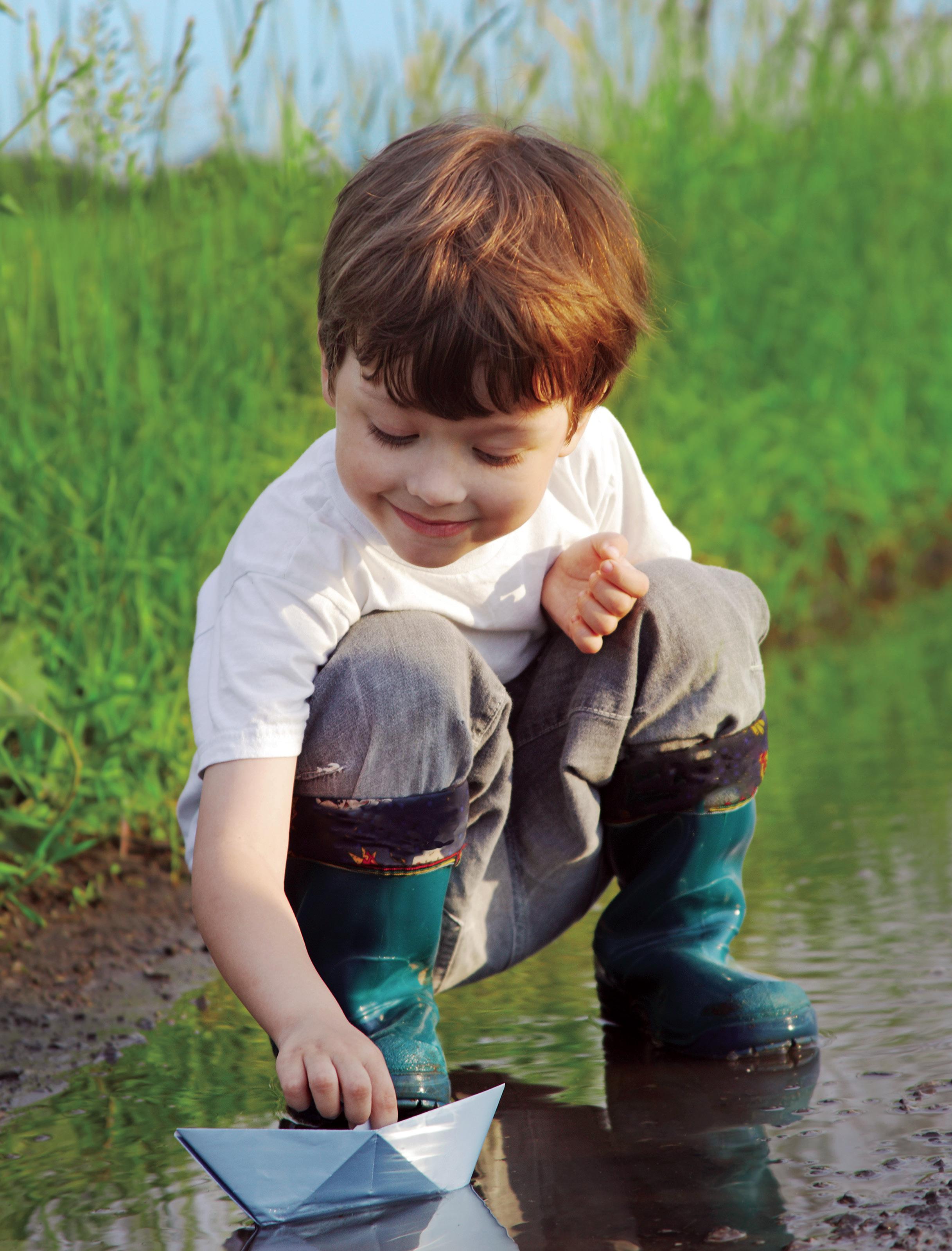
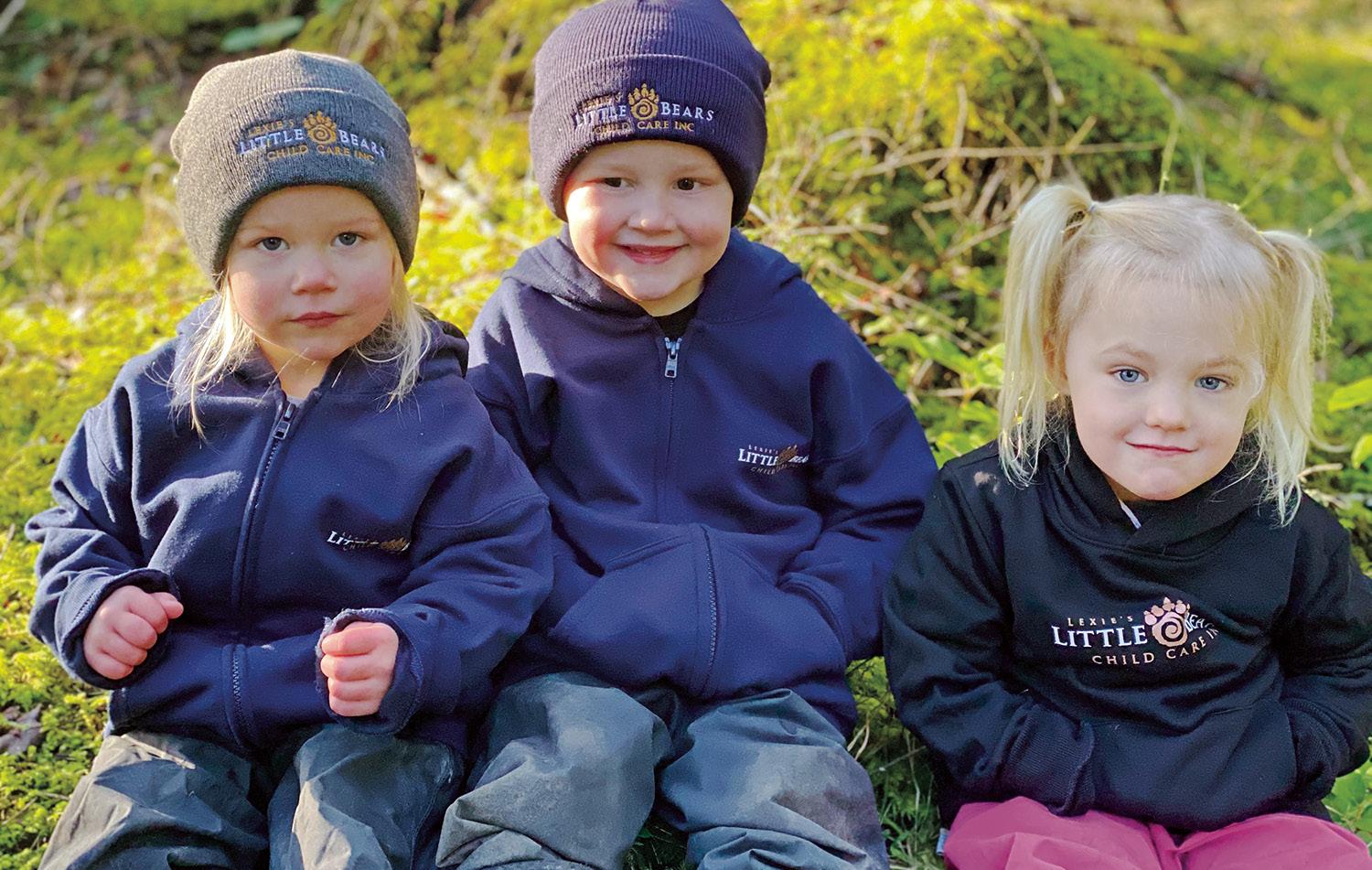
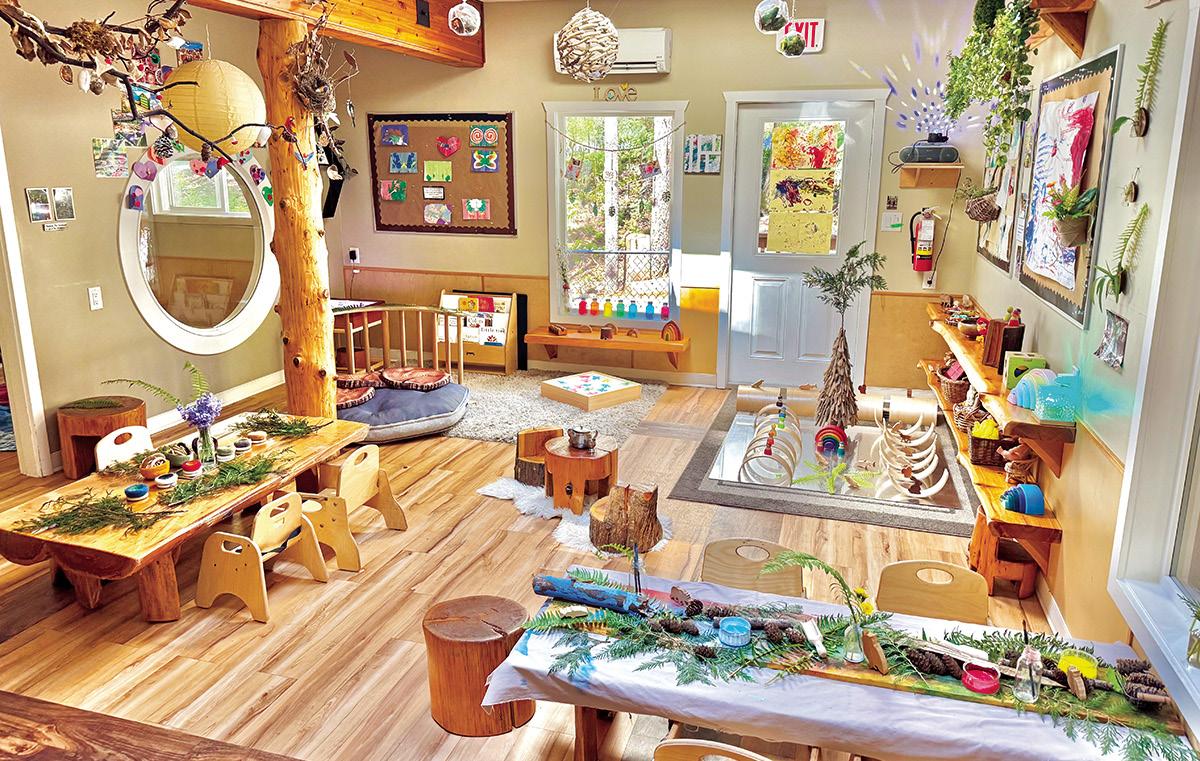

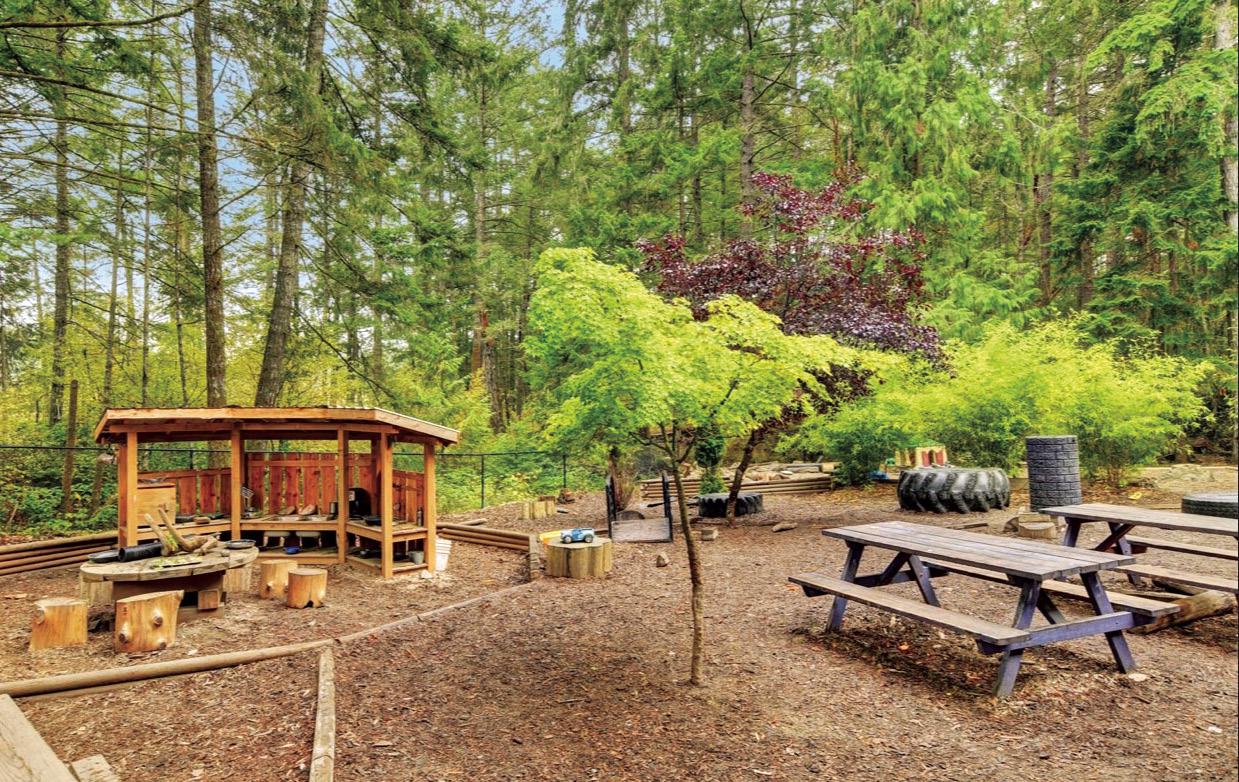
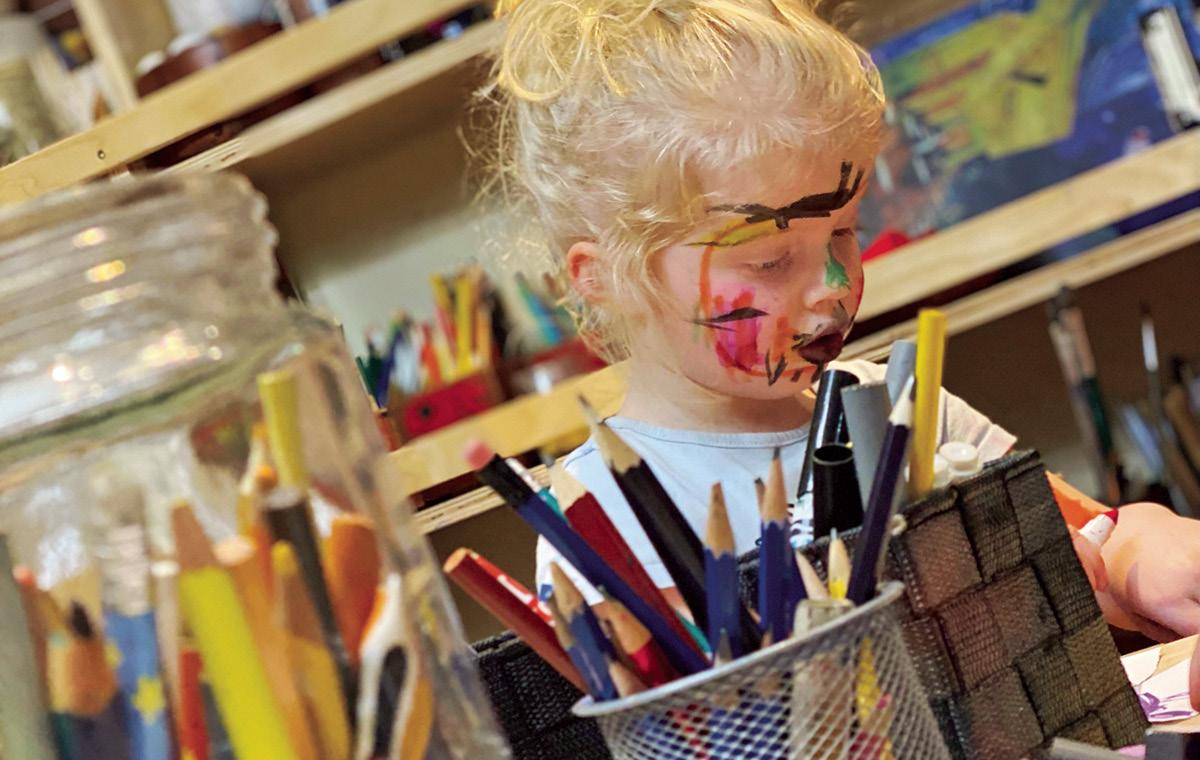






















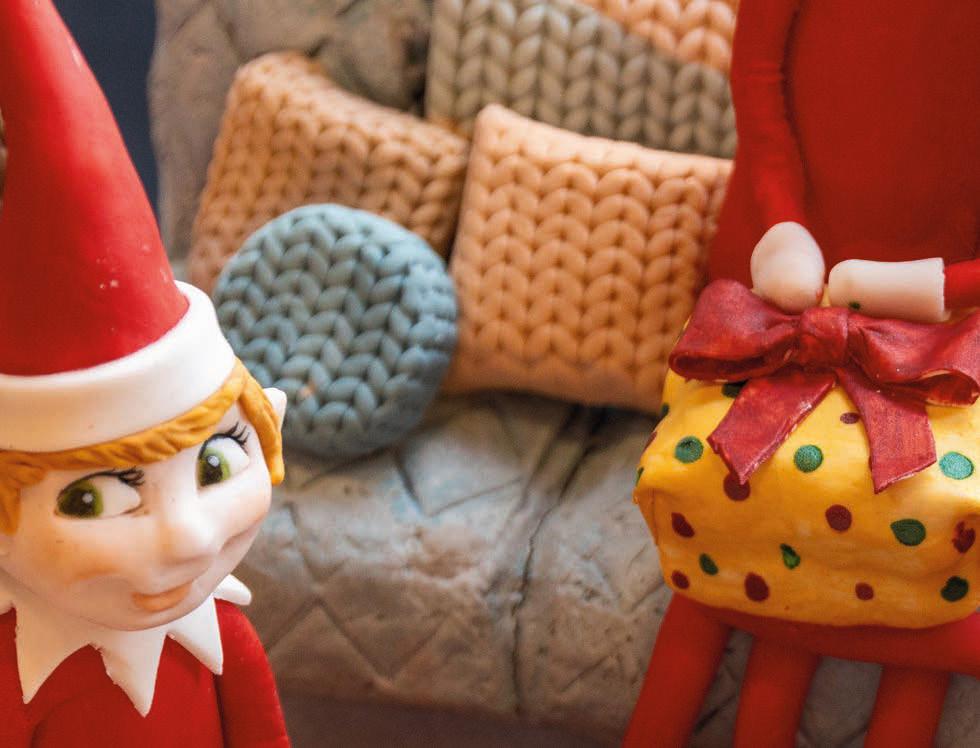
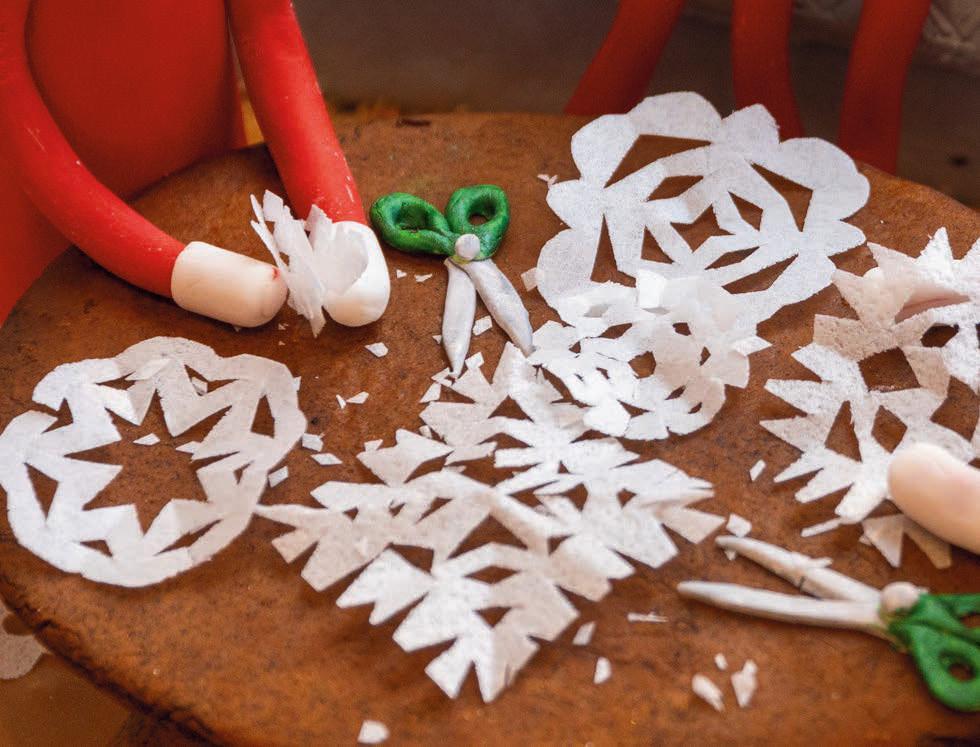

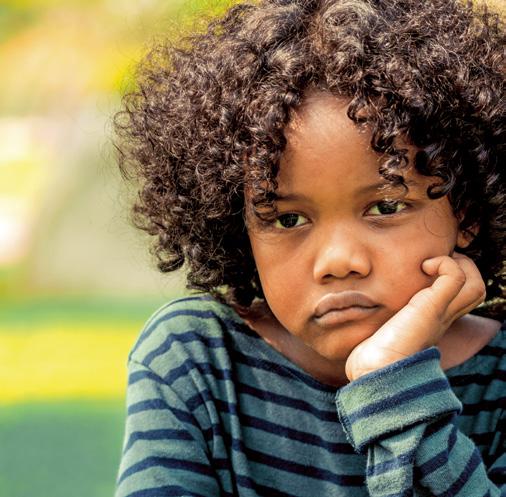


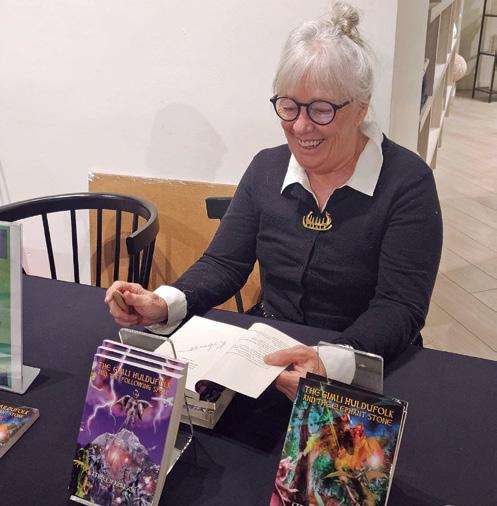
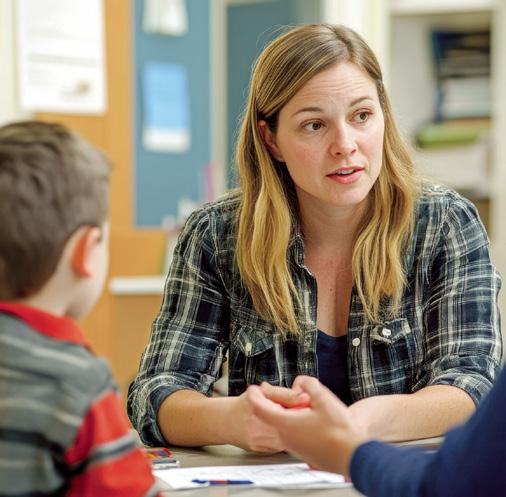

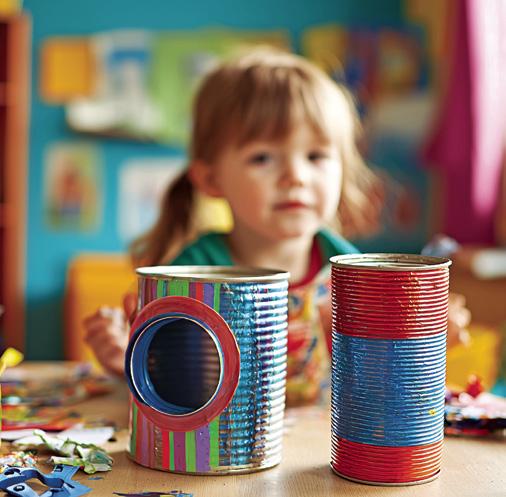
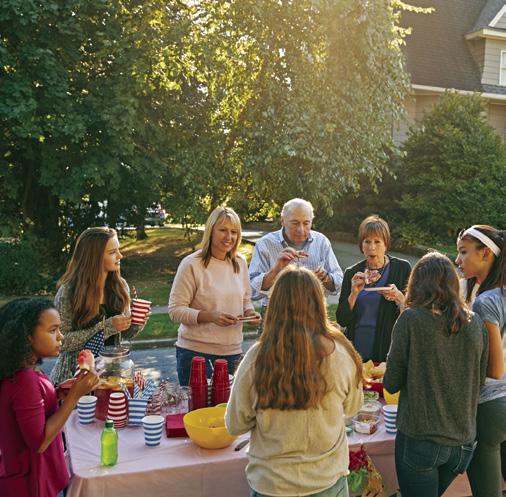
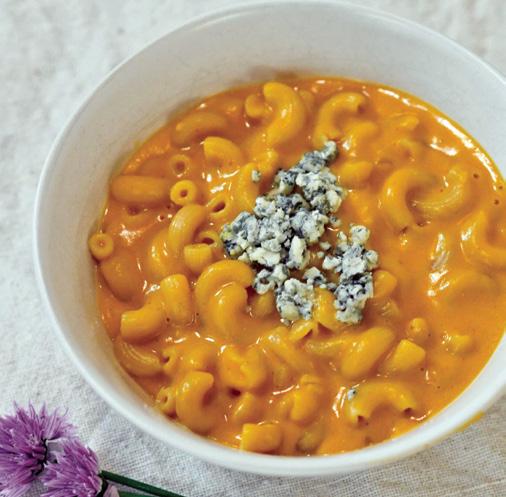
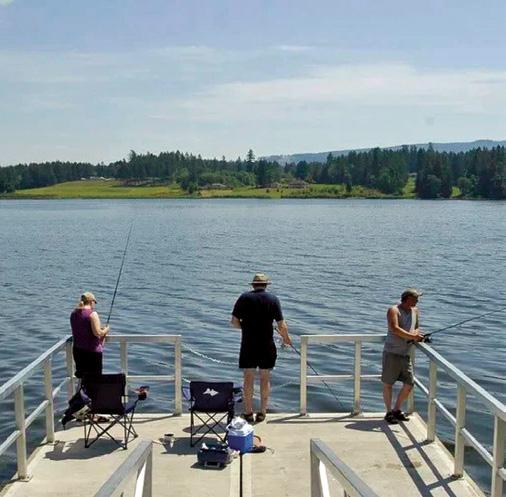



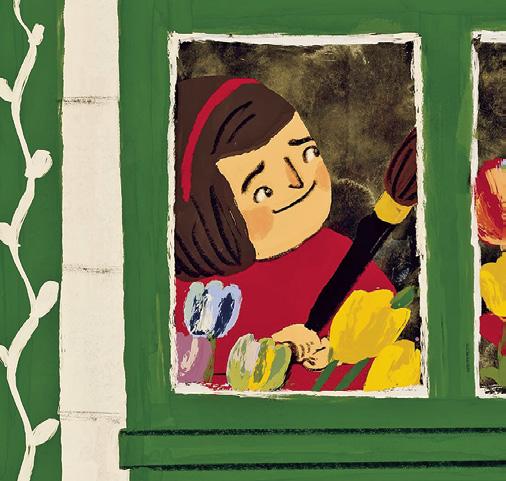
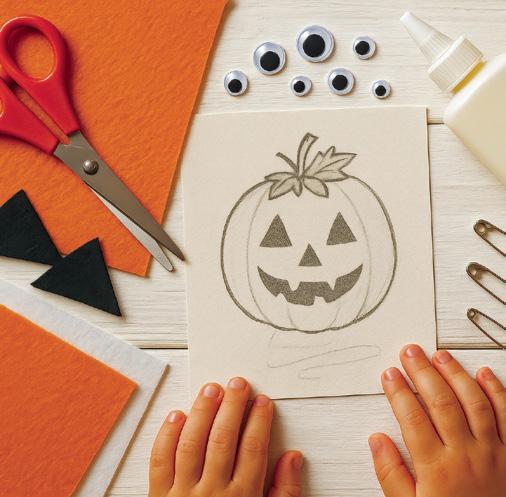























































Parenting doesn’t come with a manual, but if there was one universal truth to tuck in our back pockets, it might be this: When in doubt, play.
Most of the time when our children have a problem (whether they are a crying baby, complaining middle schooler or mopey teenager), the situation can be improved by getting creative and “shaking things up a bit.”
Then there’s the universal phrase every parent knows all too well: “I’m bored.” Whether from a preschooler or teen, boredom is not the enemy—it’s a gift. Let them “be in it.”
The imaginative play, storytelling or idea to make something that comes out of sitting in the uncomfortable feeling of having nothing else to do, can transform that dull moment into something memorable.

The cure for their woes isn’t another gadget or activity packed calendar. It’s something simpler, more powerful and always available: play, imagination and creativity—for all ages.
Have a fussy infant on your hands? Skip the complicated tricks and try making a silly face. A giggle might be just what they need. When your elementary-aged child declares that everything is “boring,” instead of stopping what you are doing to entertain them, ask them to help you solve a problem, or crank up the music for a living-room dance party.
Tween and teens need play too—though they might roll their eyes at the suggestion. While it’s tempting to let them zone out in front of a screen for hours, sometimes the best cure for that glazed-over look is a spark of creativity. Story games at the dinner table, listening to a podcast or starting a project together reminds them (and us) that play doesn’t end when childhood does.
And letting go of the feeling, that you need to constantly entertain your child, is a huge win for you too!
Parents aren’t immune to ruts either. The daily grind can leave us feeling drained and disconnected. The answer? Socialization. Thinking outside the box about how we gather with friends and other parents helps us build our village. A potluck picnic at the park with friends, an extended family hike or talking to a parent that you connect with at school pick-up can turn ordinary afternoons into something extraordinary.
So, the next time your child (or you) seems stuck, remember this simple truth: play is not just for kids. It’s the secret ingredient for joy, connection and resilience at every age.
When in doubt, play.
– Stacie Gaetz

Back in my day, there was no streaming library of shows, no pocket-sized screens with endless dopamine hits, no immediate gratification at the press of a button. If we were bored, we were bored. And eventually, something came of it: forts made of bedsheets, stories scribbled in old notebooks, role play with stuffies and old phone books, all orchestrated with nothing but a homemade costume and a little imagination.
Fast-forward to 2025, and boredom feels almost impossible. Our kids are wired for constant stimulation, and we as parents often feel pressure to provide it. But what if boredom isn’t a problem to be solved, but a gift we’ve forgotten how to give?
Imagination is like a muscle. And like any muscle, it needs practice, stretching and exposure to grow strong. When kids sit in the uncomfortable silence of boredom, they’re flexing that muscle. With time, it gets easier for them to create their own fun, stories and worlds.
And here’s the kicker: it matters for us too. A dear friend and former homeschooler mom shared with me that for years, she felt it was her job to manage every moment of her kids’ day, until she made the conscious decision to stop. Now her kids are thriving, and she feels free—even with a full-time job, and plenty of juggling. That hit home. I used to think that managing my kids’ every move—filling every gap with activities, crafts and ideas—made me a “better” mom. But really, it just exhausted me. Maybe the ideal isn’t constant management. Maybe the gift is stepping back.
Here’s the magic: once boredom is welcomed, wonder sneaks in. Kids start to see the extraordinary in the ordinary—cloud animals drifting by, a cardboard box turned boat, bugs on the sidewalk holding a protest.
Wonder is a gift we could use too. When we’re not scrambling to entertain or micromanage, we start to notice things again: the way light hits our favourite spot on the couch, a

book ready to be picked up, the joy of a phone-free walk (gasp!).
In my own home, boredom has led to:
• Creativity: Paper airplanes; elaborate drawings; kid-sized market booths where parents get to shop, and enjoy a guiltfree plate of decadent desserts made of pom poms, while paying an absurd amount of fake (well-spent) money.
• Collaboration: Siblings working together on forts, projects and role play (and yes, sometimes squabbling, it’s an inevitable part of the process).
• Life Skills and Connection: Inviting us into their play while practicing autonomy and leadership.
• Problem-Solving: “How do I re-shape this airplane so it has more speed?” “Why does this angle look off in my drawing?”
• Resilience: When things flop, they try again—without me stepping in to rescue them.
1. Set the Stage: Offer open-ended tools (paper, blocks, boxes) and step back.
2. Pause for the Cause: When the whining hits, pause before reacting. You are building your patience muscle too.
3. Notice the Wonder: Point out clouds, shadows, shapes— little details that can spark their imagination.
The shift has been striking. Instead of, “What are we doing now?” or “When can I get screen time?” I’ve started hearing, “Just a sec, Mom—we’re working on a project!”
These aren’t just cute byproducts. They’re essential life skills. Kids who learn to tolerate boredom are better equipped to face challenges later in life, whether it’s handling frustration, waiting their turn or solving real-world problems.
Letting our kids be bored is one of the best gifts we can give ourselves. By stepping out of the role of cruise director and constant dopamine supplier, we reclaim time, energy and little slices of joy that used to get lost in the shuffle. We don’t have to be their endless entertainment. We get to watch them grow into it on their own.
Boredom is an open door. For them and for us. So, the next time your kids groan, “I’m bored,” or complain (because they will), remember this: No, you don’t have to fix it, and no, you are not failing them. You’re modelling what it looks like to slow down, look up (phone down) and rediscover the wonder around you. We can stop overthinking, let go of control and remember that our nervous system deserves rest just as much as our kids’ imagination deserves freedom.
So, here’s my invitation: Let them be bored. Let yourself be bored. You both might just find the gift you didn’t know you needed.
Deb Balino is a Victoria-based writer and mom of two, navigating life in the sandwich generation. She’s the podcast host of Sass & Small Talk on TELUS/StoryHive, exploring the mental load of parenthood, sharing stories from the trenches of raising a neurodivergent family, while balancing advocacy, business and caregiving.

Toddlers don’t come with a manual and some days it feels like they should. Between meltdowns over the wrong colour cup, resistance to getting dressed and endless curiosity about everything they shouldn’t touch, parents are often left wondering, “What the heck am I supposed to do right now?”
If you’ve ever asked yourself that question, you’re not alone. Every parent of a toddler has been there: feeling stuck, second-guessing themselves and wishing there was a step-by-step guide for getting through these years. While no manual exists, there is a powerful tool you can lean on: play.
Play isn’t just fun; it’s a toddler’s first language. Children explore the world, learn new skills and process big feelings through imagination. Research shows that play lowers stress, strengthens relationships and makes cooperation more likely.
When parents weave play into daily routines, they shift the dynamic from control to connection. Instead of demanding compliance, you’re inviting your child into something they already understand and enjoy. For toddlers, this feels safe and engaging which makes cooperation more likely. Who doesn’t want more connection and cooperation with their toddler?
The good news? You don’t have to be endlessly creative or energetic. Small doses of playful connection can go a long way. Here are a few ways to try it at home:
• Turn routines into games. Try racing to see who can put shoes on first, or sing a silly song while brushing teeth.
• Add pretend to tricky tasks. The toothbrush becomes a car wash for teeth. The laundry basket turns into a rocket ship.
• Role-reversal play. Let your toddler be the “parent” giving you directions for two minutes. This helps them feel empowered and often makes them more willing to follow directions afterward.
• Sprinkle in silliness. Use a funny voice, make a pretend mistake or move like your favourite animal on the way to the car. Laughter is one of the fastest ways to diffuse tension.
What if being playful doesn’t come naturally?
• You didn’t grow up with playful parents. Start small: a silly wink or quick race is enough.
• You’re tired. Try low-energy play like a high-five game or a funny voice.
• You worry about losing authority. Remember: playful doesn’t mean permissive. You can be both silly and firm.
• You don’t know what to do. Let your toddler lead. They’ve got enough imagination for both of you.
For many parents, being playful doesn’t always come easily. You may feel awkward, exhausted or unsure of what to do. That’s okay. Play doesn’t have to be elaborate or constant. Even 30 seconds of silliness can shift the energy, reduce resistance and create a moment of connection.
The truth is, parenting toddlers will never come with a manual, but you don’t need one. Imagination and playfulness are often the next best thing. They help you guide your child through big feelings, lighten the hardest moments and remind you both that connection matters more than control. With play in your pocket, you already have one of the best tools there is.

Darcy Harbour is a registered clinical counsellor and the director of Harbour Family Counselling, a group practice in Victoria specializing in family, couples and individual counselling. She helps parents and children manage big emotions and strengthen family connections. Learn more at harbourfamilycounselling.ca



The LINC Youth Centre in Courtenay transforms into a haunted wonderland from October 23 to 31.
Created and performed by local youth, it’s a spooky, community-driven event with playful scares for families. courtenay.ca 1 2 4 3 5
Youth to Sea, offered by Ocean Wise, is a free, experiential eight-month leadership and conservation program for Canadians ages 15 to 18. Participants engage in immersive ocean journeys, soft-skills workshops and community service projects. ocean.org

Complete with costumed characters, live music, crafts and trick-or-treating along vendor-lined streets, this family-centered festival transforms downtown Government Street into a Halloween playground on October 26. gvfs.ca

Community Bat Programs of BC’s Bat Week (October 24 to 31) is designed to dispel the myth that bats are scary. Families can join educational events, bat counts, and habitat activities to learn about these fascinating creatures. bcbats.ca

October 16 to 26: Ten days of in-person and online screenings of moving image art—experimentation, abstraction and animation—engaging for children and adults alike. Little Skies youth film festival and hands-on workshops coming in 2026. antimatter.ca


Meant Well Books is a little travelling bookstore you’ll see out and about at various markets and events around Victoria. This creative mobile shop brings a curated selection of books to you online or at their latest stop. meantwellbooks.com

From November 7 to 9, Cumberland’s Woodstove Music & Arts Festival invites families to enjoy local music, creative workshops and arts performances at this non-profit community event presented by Cumberland Culture Arts Society. woodstovefestival.ca 6 7 8 9 10
Starting this school year, Grade 10 students across BC will learn life-saving CPR and AED skills as part of the updated Physical and Health Education curriculum. This addition equips young people with confidence and critical emergency preparedness. news.gov.bc.ca

Grab the family and line up along both sides of Methuen Street in Ladysmith on November 27 to watch the kick-off to the Ladysmith Festival of Lights: The Light Up Parade! ladysmithfol.com

This tool, part of the BC Government’s ERASE Bullying Strategy, allows you to send a secure, confidential message to your school safe coordinator if you see, hear, or experience something that isn’t right in your school. erasereportit.gov.bc.ca
Could you imagine, back then when you tracked all your newborn daughter’s naps in the app and weighed your baby weekly, that everything would be fine?
Could you imagine a world where you slept through the night and woke up to morning cuddles in bed while your sevenyear-old watched Meekah and Blippi on your phone? Could you imagine a night without interruption, a morning without crying? Could you imagine that words like “purple crying” and “diaper rash” and “sleep pressure” are no longer reference points? Can you imagine a bathroom cupboard without Baby Gaia, D-drops and diaper cream?
Can you imagine that one day you’ll go to Costco, and your list will contain chicken pot pie, Chicago Mix, coffee, bread, panda cookies, mini-wheats and smoked salmon, but no diapers or baby
wipes? Did you ever think when you shopped at Costco with a baby on your front in a carrier, dripping with sweat and getting directed to the first aid room to nurse when she lost her cool in front of the cashier, that she would not only graduate to sitting in the cart but eventually become a useful sidekick, grabbing the coffee for you and placing boxes of mini wheats underneath?
Could you imagine bumping into a friend at a store, and your daughter and “Dance Kendall” running along together on their cereal-fetching mission? Could you imagine that she would help unload the car and that you would pass her two giant bags of Chicago Mix and she would know to put one in the cupboard and set the other by the door for grandma? Did you ever think she would pick out flowers for you and you would divide the bouquets into five small vases—one for the kitchen table, two for each bathroom,
one for your office and the last one into a fox-shaped vase for her room?
Did you ever even think she would talk? That you wouldn’t just be stuck guessing what the different cries meant? Is she hungry? Hot? Cold? Surely it couldn’t be another dirty diaper. How infuriating that you were stuck in an endless math equation of: How long since the last feed? How long since the last diaper change? How long until the next nap?”
Did you think back then, when your Facebook feed was full of ads for lactation cookies and tips on baby-led weaning that you could one day just serve the family all the same meal—that except for salad and curry, she’d eat the same thing as everyone else? Did you ever think you could just throw a couple granola bars in your purse instead of pre-chopping strawberry bits in a Tupperware that would no doubt get forgotten in the car

until the “fur” had grown into an unwieldy science experiment?
Did you ever think your baby would go on to perform a Toy Story song at the Farquhar for her dance recital and that you’d be putting blush and lipstick on her to counter the stage lights? Could you imagine a summer where she decided to wear her costume every day to science camp? That she would visit the bug zoo dressed like Jessie the cowgirl and make purple coloured slime?
Did you ever imagine this? I don’t know if you could, back in the fog of sleep deprivation and constant breast feeding and your back hurting from baby wearing. But you sure did hope for it. It’s hard to imagine, now, having a sevenyear-old, what future self she will turn into. What music will play at the living room dance parties? When will she get tired of fetching mini wheats at Costco? When will she graduate from stage makeup to everyday makeup? It’s so hard to imagine what type of mother you’ll need to be. What the pre-teen version of “purple crying” is. What the teenage version of “sticker club” will be. What the young-adult equivalent of braiding hair at recess is.
She’s already shed her baby-self, her toddler-self, her kindergarten-self. And you’ve shed your shell-shocked new mom version of yourself and your “…but I thought we’d gotten the sleep schedule down!” toddler-mom self and your “overwhelmed by PAC emails” kindergarten-mom self.
It’s hard to imagine what the future holds. What type of older kid and preteen and teenager she’ll become. Who you will become to her.
For now, you can only imagine.

Julia Mais is a policy and communications professional in Victoria. She looks for beauty in the everyday through writing, photography and the outdoors. She lives in a messy, cheese-filled home with her husband and young child.






Screens are part of family life, and sometimes they’re exactly what’s needed. But kids’ imaginations grow best when given chances to play, explore and connect without TV, video games, phones, computers and tablets. With just a few small habits, families can spark creativity and joy every day.
Instead of asking, “How was your day?” try, “What colour was your day?” (or even “What animal?” or “What shape?”). Kids choose, and the family guesses what it means—Was red an exciting recess game, or orange a silly moment in gym class? This playful twist not only gets kids talking, but it also helps them
reflect in a way that feels fun and imaginative. Many families find it becomes a ritual that makes the transition home something to look forward to. You could even create a colour chart by the door as a fun way to check in when the kids arrive home.
Mealtimes can be a launchpad for creativity. Try “family Mad Libs,” where everyone adds silly words to complete a story, or pick a random word and invent its meaning together. The sillier the better—kids love when the grown-ups get goofy too. These little games turn dinner into connection time, bubbling with
laughter and imagination. The classic “Would you rather?” game is another hit. Try something like: Would you rather swim in a bathtub full of Jello or drive a car made out of marshmallows?
Everyday objects can spark creativity too. Collect beach or forest treasures, bottle caps or household recycling and turn them into art. Not only does this encourage problem-solving and design skills, but it also teaches kids about caring for the environment. One project might become a colourful collage, another a homemade sculpture. It’s messy, fun, and meaningful.
Podcasts are a wonderful screen-free tool. Whether it’s a storytime series or an educational adventure, audio sparks imagination while keeping kids’ hands free for drawing, LEGO or pretend play. For highly rated kids’ shows, try the Go Kid Go network.
A dedicated play zone stocked with simple, sturdy toys (blocks, costumes, art supplies) and free of “off-limit” temptations (like delicate furniture, expensive art or open outlets) encourages kids to dive into independent play. When children know they have a safe, welcoming spot to be themselves, their creativity naturally flourishes.

Experts recommend that children ages two to five enjoy no more than an hour of high-quality screen time daily, while older kids may handle more, as long as it’s balanced with sleep, activity and family time. But remember, there’s no need for guilt if you use screens when you need them. Think of screens as one tool among many; not the enemy.
By weaving in small traditions—colour games, story swaps, recycled art, podcasts and safe play spaces—parents can give their kids daily chances to flex their imagination. It’s not about eliminating screens completely, but about creating a balance where creativity can shine. And who knows? The next time you ask your child what colour their day was, the answer might just be “rainbow.”
• Colour Your Day: Ask, “What colour was your day?” and guess what it means.
• Story Games at the Table: Play Mad Libs, invent silly words or try “Would you rather?”
• Recycled Art: Turn outdoor finds or recycling into collages and sculptures.
• Podcasts for Play: Try kid-friendly podcasts to spark imagination while little hands stay busy.
• Safe Play Space: Set up a zone with blocks, costumes and art supplies where kids can play freely.
Asta Mail and her daughters, Sayla and Savea, created The Penny and Joe Podcast, which you can find on Spotify and Apple Podcasts.



Congratulations on growing your family! This is the fourth part of a five-part series about the trimesters of pregnancy. We will visit each of the three-month blocks and talk about the information, tasks and ideas that belong to that time.
The first 12 weeks of a baby’s life is full of joys. The smell of a new baby, the sweetness of feeling them cuddle into you, the silkiness of their skin, the bliss of their little toes. The feeling of accomplishment, of learning new things, of falling in love—all of these firsts are wonderful.
But Trimester 4 is also a challenging time for everyone. The baby doubles their birthweight in the first four months, so they will be very focussed on eating and resting at first—not much fun. The amount of awake time for the baby gradually increases over the fourth trimester, until by three months, they will be smiling, interactive and interested in watching you. A big (and welcome) change!
Feeding the baby can be challenging. Chest/breastfeeding is a learned physical skill. It takes time and practice to get good at
it, and for it to feel “natural.” Don’t hesitate to ask your doctor/midwife for a referral to a lactation consultant.
Feeding isn’t the only thing that can take some time to get used to. You will need to learn to read baby’s cues:
• Spend time just sitting and watching your baby.
• Respond quickly to the little cues that mean “I’m hungry,” such as rooting (turning their head and opening their mouth), sucking on their hands, making lip-smacking noises and moving their mouths. Crying is not a sign of hunger, but rather of despair, when the early cues are not recognized. “Are they NEVER going to feed me?”
• Always try feeding first. If that doesn’t work to settle the baby, maybe they are just feeling lonesome or bored. Try cuddling, swaying, singing and patting.
• Try a diaper change. Even if the diaper is not dirty/wet, all that undressing and re-dressing is like a reset button for many babies.
• Remember that an unhappy baby almost always gets happier when you take them outdoors—fresh air works miracles.
• Put the baby in water; a bath often relaxes an infant.

The childbearing parent’s body is gradually recovering from the hard work of growing and then birthing a baby. Healing takes time and rest. Don’t expect to “bounce back.” Treat yourself gently.
You need to stay home and in a semi-horizontal position for several days.
• After four or five days, you could go out for a short walk, with a companion.
• You really should not be alone at home with the baby for long periods in the first week of the baby’s life. It’s too overwhelming.
• Your partner, who was probably with you during labour, needs sleep too. Make sure the other parent also gets naps during the first few days.
Take care of the parents. Make sure you both get...
• Sleep: Make up for the night wakings.
• Good food: When things are disorganized—ask friends and family to bring a meal.
• Company: If there is a parent who is working outside the home, make sure the stay-at-home parent gets visitors and support.
• Entertainment: Caring for a baby intensively can get a little boring. Funny movies and good music can help.
• Exercise and fresh air: After the first week or so, a daily walk can help improve mood, and sleep.
A postpartum doula can provide practical household help, combined with baby care skills and experience.
Ask for support from family and friends as well. If they want to be part of your baby’s community, the first way they can do so is by helping you.
• La Leche League is a volunteer organization providing parent-to-parent support for chest/breastfeeding.
• Baby Groups are available at many Neighbourhood Hous es, at the Public Health Units and at Mothering Touch.
This is the time when you are becoming a family. Think about and talk about how you would like your family to live. Do things together. There is a temptation to split the work up so one parent cares for the baby and the other does the shop ping/cooking/cleaning/laundry. Instead, try doing things with all three of you together, if you can. It gives both of you time with the baby and teaches you to include your baby in family activities.
Try to have a family cuddle time, dancing and singing time or family bath time every day.
Eva Bild is a childbirth and lactation educator and grandmother. She is the founder of Mothering Touch, where she facilitates Baby Groups on Tuesday and Thursday mornings. Learn more at motheringtouch.ca






The Province of British Columbia launched a publicly funded invitro fertilization (IVF) program in July.
As of July 2, eligible BC residents have access to one-time funding of up to $19,000 toward the cost of a single standard IVF cycle, including treatment and medications.
“Knowing that the government is stepping in to help with funding makes a world of difference,” says Rachelle Pastilha, an IVF patient in BC who was diagnosed in 2008 with endometriosis.
“It brings real hope—not just for us, but for so many others out there who are going through the same thing. So, thank you, from the bottom of my heart. This means more than words can say—for my family, and for countless others.”
Infertility is a disease of the male or female reproductive system defined by the failure to achieve a pregnancy after 12 months or more of regular unprotected sexual intercourse. According to a recent report from the World Health Organization, one in six people globally are affected by infertility over the duration of their reproductive lives. IVF is a fertility treatment that includes a complex set of procedures that can lead to a pregnancy. IVF costs an average of $20,000 per round and many people need two to three rounds to be successful.
“For people needing to access IVF care to start a family, the costs can make it simply out of reach,” says Josie Osborne, BC Minister of Health.
“Being able to have a child shouldn’t depend on how much money you make. That’s why today we are launching BC’s
first-ever, publicly funded IVF program that will ensure more people can access this life-changing treatment and bring hope to thousands of British Columbians on their path to parenthood.”
Fertility clinics that are participating in the publicly funded fertility program will submit applications on behalf of their patients to the Ministry of Health. Applications will be reviewed in the order they are received, with provincial funding provided directly to a patient’s fertility clinics to limit up-front costs. BC will deliver the program through Olive Fertility Centre, Pacific Centre for Reproductive Medicine and Grace Fertility and Reproductive Medicine.
“This is a monumental moment for individuals and couples struggling with infertility, who dream of starting or growing their families but rely on advanced fertility services,” says Niamh
Tallon, clinical medical director at Olive Fertility Clinic.
“The BC government’s new funding initiative acknowledges the significant financial barriers many face. By addressing these challenges, this program is a critical step toward ensuring more equitable access to fertility care, aligning BC with other provinces that have already embraced similar measures.”
Funding amounts will be based on household income. Households with a pre-tax income of $100,000 or less will be eligible for the full $19,000, with benefits phasing out for households earning more than $250,000. The Province estimates that the program will fund between 1,100 and 4,500 IVF cycles, with the funding available this fiscal year.
Laura Spencer, certified fertility coach, says she was elated to hear that public IVF coverage was finally coming to BC, but was disappointed to learn that coverage is tied to income and not medical need.
“I feel equal parts joy for the people who are fully covered with the $19,000, and heartache for those who are ineligible due to income, age or the long wait times,” she adds.
“IVF isn’t a luxury; it should be considered the same as any other medical treatment.”
To be eligible for the program, individuals must be at least 18 years of age, 41 years of age or younger at the time of application and enrolled in the Medical Services Plan.
Learn more about the IVF program at gov.bc.ca/gov/content/health/ accessing-health-care/publiclyfunded-ivf-program

Stacie Gaetz is the managing editor of Island Parent Magazine and the proud mama of a delightful daughter and silly son who fill her days with love and chaos. She thoroughly enjoys supporting, connecting with and informing parents through interesting articles like this one. Reach her at editor@islandparent.ca.










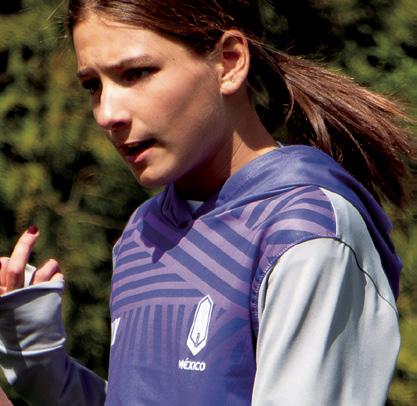








he Family Favourites results are in! Who has the best products, services and experiences? We asked and you answered. The Family Favourites were developed to recognize quality family retailers and service providers in our community. Our readers were invited to vote online at islandparent.ca for their family favourites in 42 categories. The response was phenomenal! Thank you to everyone who voted and sent us such wonderful feedback. We have tallied your votes— here are your 2025 Island Parent Family Favourites!
FOOD TRUCK
Winner: Greek on the Street
Runners Up: Deadbeetz, Bannock Truck
ICE CREAM SHOP
Winner: Parachute
Runners Up: Cold Comfort, Beacon Drive-In
BURGERS
Winner: Bin 4 Burger Lounge
Runners Up: Big Wheel, Red Robin
PIZZA
Winner: Pizzeria Prima Strada
Runners Up: My-Chosen, Mods Pizza
FAMILY DINING
Winner: White Spot
Runners Up: Boston Pizza, Red Robin
FOOD PREP SERVICE
Winner: Refire Kitchen
Runner Up: Fresh Prep, Hello Fresh
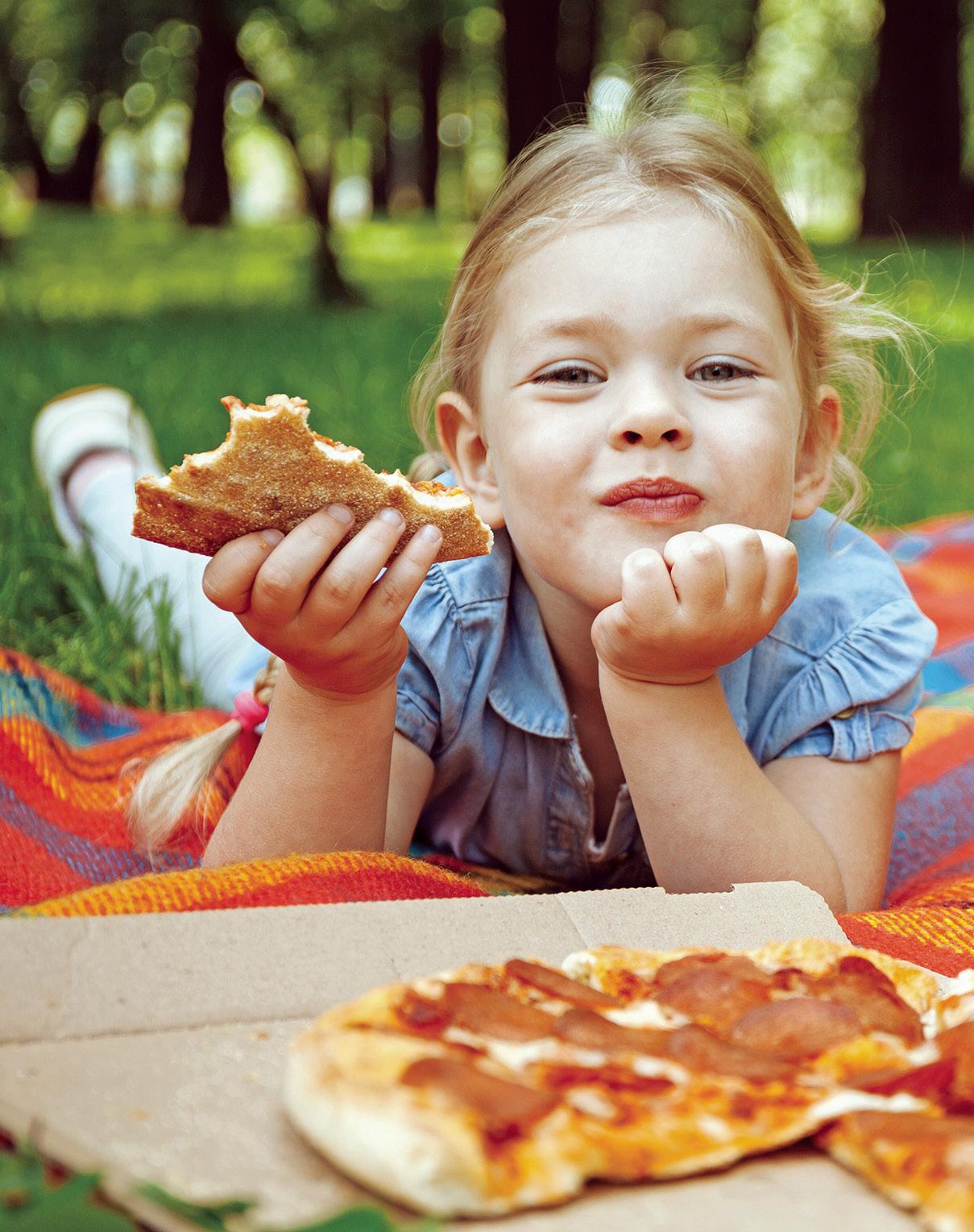
ESTHETIC SALON
Winner: Queen Bee Nails
Runners Up: Oasis Nail Spa, H’s Nails & Spa
OPTOMETRIST
Winner: FYI Doctors
Runners Up: Optimed, Family Eyecare
ORTHODONTICS
Winner: Paradigm Orthodontics
Runners Up: Shoreline Orthodontics, Common Sense Orthodontics
HAIR
Winner: Haven Salon
Runners Up: The Natural, Brothers Barbershop
DAY SPA
Winner: Kingfisher
Runners Up: Heaven Spa on the Rock, Eden Street
DENTIST
Winner: Parkway Dental
Runners Up: Peiatric Dental Associates, Urban Smiles
PHYSIOTHERAPIST
Winner: Tall Tree
Runners Up: Parkway, Shelbourne Physio
FINANCIAL PLANNER
Winner: Sunlife
Runners Up: TD Bank, Edward Jones
PRESCHOOL/CHILDCARE
Winner: Belmont Park Preschool
Runners Up: Children of the Island, Hello Friends
ARTS OR THEATRE PROGRAM
Winner: Kaleidoscope
Runners Up: 4 Cats, Stages
BIRTHDAY PARTY LOCATION
Winner: Flying Squirrel
Runners Up: WildPlay, City Centre Park
SUMMER CAMP
Winner: Camp Imadene
Runners Up: Science Venture, Westshore Parks
OVERNIGHT CAMP
Winner: Camp Imadene
Runners Up: Camp Qwanoes, Camp Homewood
SPORTS PROGRAM
Winner: Vikes Camps
Runners Up: Braefoot Sport Programs, JDF Soccer
RECREATION CENTRE
Winner: Westshore Parks & Recreation
Runners Up: Commonwealth, Panorama
LIVE SPORTING EVENT
Winner: Victoria Royals
Runners Up: Victoria HarbourCats, Pacific Football Club
PLAYGROUND
Winner: Gyro Park
Runners Up: Parksville Community Playground, Sarah Beckett Memorial Playground
BEACH
Winner: Esquimalt Lagoon
Runners Up: Witty’s Beach, Island View Beach
PARK
Winner: Beacon Hill Park
Runners Up: Goldstream Provincial Park, East Sooke Regional Park
ATTRACTION
Winner: Malahat Skywalk
Runners Up: Butterfly Gardens, WildPlay
FAMILY GETAWAY
Winner: Parksville/Qualicum
Runners Up: Tofino, Cultus Lake
CAMPGROUND
Winner: Goldstream Park Campground
Runners Up: Gordon Bay Campground, Living Forest Oceanside Campground
HIKE
Winner: PKOLS Mount Douglas Park
Runners Up: Mount Finlayson, Mount Work Regional Park
CHILDREN’S CLOTHING
Winner: Sailor Jack
Runners Up: Once Upon a Child, Old Navy
BABY
Winner: Carter’s
Runners Up: Sailor Jack, T.J.’s
TOYS
Winner: Mastermind
Runners Up: Kaboodles, Buddies
CONSIGNMENT
Winner: Once Upon A Child
Runners Up: Sailor Jack, Kinderbeez
GROCERY
Winner: Thrifty Foods
Runners Up: Country Grocer, Save on Foods
HEALTH & ORGANIC
Winner: LIfestyle Market
Runners Up: Whole Foods, Root Cellar
FARMERS MARKET
Winner: Moss Street Market
Runners Up: Esquimalt Farmers’ Market, Old Farm Market
BOOKS
Winner: Bolen Books
Runners Up: Russell Books, Munro’s Books
PHARMACY
Winner: Pharmasave
Runners Up: Heart Pharmacy, Joe’s Family Pharmacy
PET STORE
Winner: Bosley’s
Runners Up: PetSmart, Paws on Cook
GARDEN CENTRE
Winner: Gardenworks
Runners Up: Hilltop Gardens, Dinter Nursery
BIKE SHOP
Winner: Re-Buy-Cycle Shop
Runners Up: Westshore Bicycles, Bishop’s Family Cycle
CAR DEALERSHIP
Winner: Galaxy Motors
Runners Up: Glen Oak Ford, Campus Nissan

Much like money is energy, social wealth is energy, too.
Launching anything on your own can feel hard, so I find the path of least resistance is to collaborate. I wanted to organize a private family fun day, so I sent a message out to a few moms in the locale asking if anyone wanted to help. I got a message back from one mom saying, “Yes, let’s meet for a coffee to make a plan.”
Within a few days we met and decided on a location that was familiar to our kiddos and had washrooms. We looked at the weather and decided on the warmest day—less than a week away. Regarding what to bring, we decided on lawn bowls, garden games,
frisbee and a ball. We would bring a few extra snacks and drinks and as many chairs as we could get our hands on.
We each sent a few messages and voilà—we created a private family fun day—with six families joining us over three hours.
We played lawn bowling and frisbee with the children when we first arrived, then they warmed up and we barely heard from them for the second half, enabling us to connect deeply with some of the wonderful families we kept meaning to do something with but never have.
I didn’t put this event on to get anything back—I needed this, just as much as the other families who came. It was
fun and therapeutic, and we all went home feeling lighter and fulfilled.
Two days later, I got a call from one of the moms who attended: “Would I like a box ticket to see Bush in concert that night?” “Ummmmmmm, yes please!” And so, I went and had the time of my life, singing and dancing along with five moms and Gavin Rossdale (a few extra folks who were also there).
Would I have gotten this invite if I hadn’t put on the family fun day? Maybe, but the friend who invited me, is well connected and in demand, she has many mom friends that she could have invited, and I am still relatively new in town.
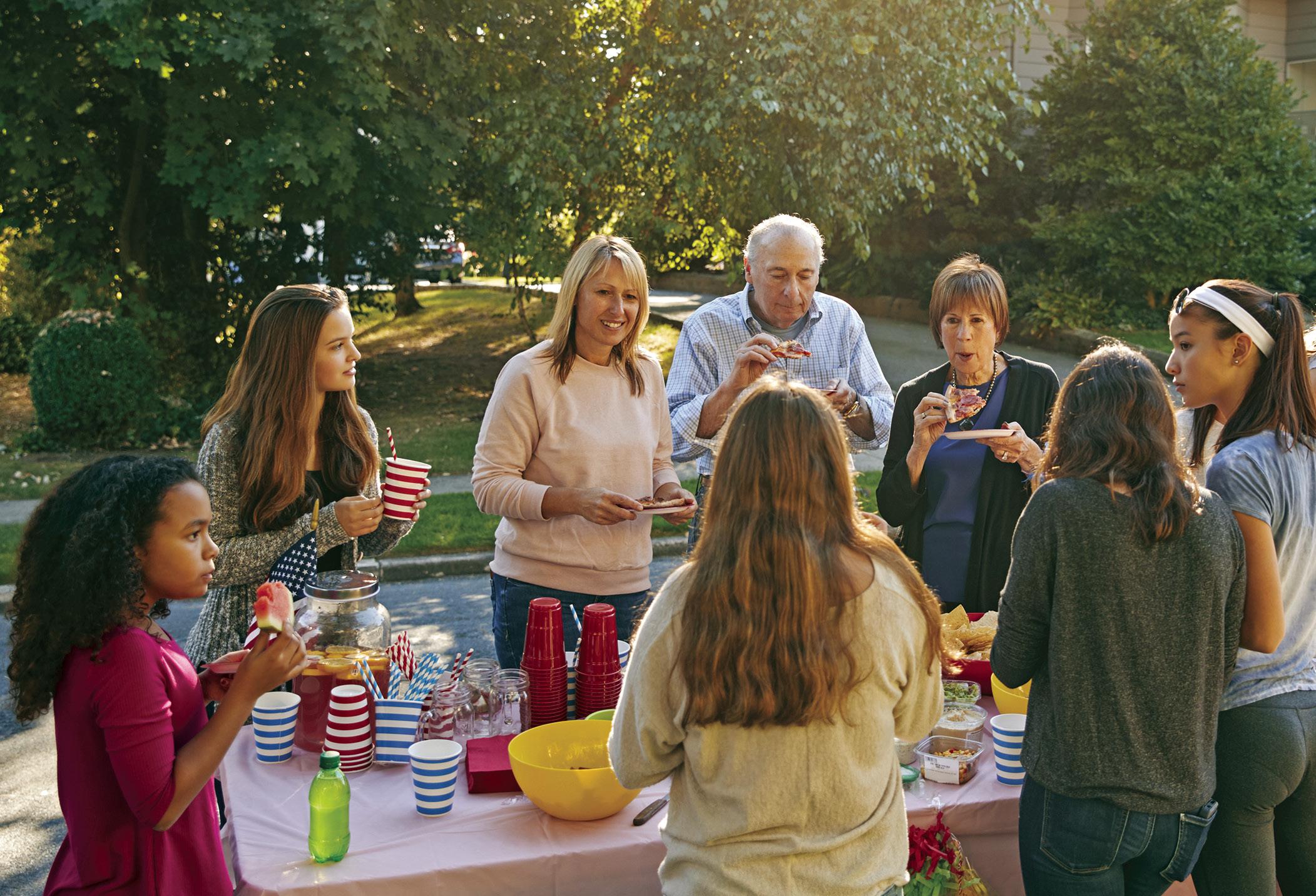
I know that organizing events can feel hard, when we are juggling all the things, but if you have an impulse, I encourage you to act! See if someone else wants to help, pick a date, location, decide what to bring and trust that it will all come together—easy peasy!
Shelley Doyle is a social wealth strategist, a British expat on Vancouver Island, a mum of two, a master’s student at Royal Roads University and host of the Rediscovering Connection podcast. Find out more at thecommuniverse.com.


You come first at Olive. Always. We understand that every fertility journey is unique. We are here to support you every step of the way on your path to parenthood.

Olive Fertility Centre is one of Canada’s leading IVF and prenatal diagnosis centres, with clinics in Vancouver, Surrey, Kelowna and Victoria. We offer inclusive fertility care for those with infertility or secondary infertility, LGBTQ2SIA+ persons and people needing donor sperm, donor eggs or surrogacy, egg freezing, and beyond.
Vancouver Island’s only full-service IVF clinic. 545 Superior St. Victoria, BC | 250-410-1664 | olivefertility.com/victoria

With the increasing tensions south of the border, more Canadian families are choosing to travel within their own country. Free admissions to many Canadian National Historic sites and parks this summer further sweetened the attraction of staying in Canada.
My family and I took full advantage of exploring our home country when we spent one month in Nova Scotia, New Brunswick, PEI, and Newfoundland. It was fabulous that our children are teens, so they are old enough to remember learning about Canada and our family history. They’ll also have fond memories travelling with their grandparents.
Our family of five and mother-in-law flew from the West Coast to the East Coast. We started in Halifax, Nova Scotia. We swam in the Atlantic Ocean at grandma’s favourite beach, Melmerby Beach. This is the location their grandma swam at every summer through her teenage years. The beach has amazing sand dunes and the wind rustling through the grass added to the ambience. From the shore, you can even see PEI and Cape Breton.
We also visited the Hank Snow Country Music Hall of Fame and Museum. In 2006, my husband’s grandpa and brother were inducted into this Country Music Hall of Fame. It was such an honour to show our children the pictures of
their great grandfather in a museum. It was neat for our children to drive through the small towns where their grandparents grew up.
After my mother-in-law flew home, we drove to New Brunswick. We loved the covered bridges and we even waited out a downpour inside the St. Martin’s Sea Cave.
The scenery was stunning, and my youngest daughter’s quote about the fog described the view perfectly: “The sailboats look like they are in an ocean graveyard.” We also learned that you can sunburn through fog.
PEI was everything I expected it to be plus more. The stunning red sand, cliffs, white sand beaches, rolling hills and farms with red dirt were scenery that I never tired of. My parents joined us in PEI.
When I was in high school, I played Marilla in Anne of Green Gables, so I was especially excited to tour the Anne of Green Gables historic site. We enjoyed learning more about the author and her life on the Island. Next, we visited L.M. Montgomery’s cousin’s house which is still owned by descendants of the Campbells. The home exactly fit the description of Anne’s house and was the highlight of our L.M. Montgomery touring.
From PEI, we took the ferry to Cape Breton. Our oldest daughter, my husband and my dad enjoyed hiking the Skyline Trail in Cape Breton. We enjoyed driving the Cabot Trail and the terrifyingly beautiful ocean views from up way too high on a winding road.
After Cape Breton, we took an overnight ferry to Newfoundland. We immersed ourselves in the life of locals by spending the day at the Bowring Park outdoor pool in St. John’s. It was fun to listen to accents, and everyone was friendly. There were a few times when we didn’t know what people were saying and they didn’t know what we were saying. As we learned during our “screech in” ceremony, you can say “ay b’y” to agree with someone (if you are unsure what they are saying). Our ceremony included kissing a cod and drinking a shot of screech (rum).
We stayed on Jelly Bean Row (colourful houses on a steep hill in St. John’s). At the George Street Festival, we received a complimentary iconic Newfoundland Sou’wester rain hat.
Another highlight was visiting mile 0 where Terry Fox began his Marathon of Hope in St. John’s on April 12,1980. The coves, cliffs and mountains in Newfoundland made us feel like we were in Hawaii.
Our children loved bonding with their grandparents and immersing themselves in the unique culture in each province. It was the summer of a lifetime to make family memories with my parents and my husband’s mom.
It warmed my heart to see our teenagers explore our gorgeous country and appreciate their roots. Perhaps, one day our children will bring their children travelling in Canada and my husband and I will join them.


From struggling to read and falling asleep every time she opened a book to an accomplished writer with 11 books in print and tens of thousands of copies sold. The story of Victoria author Kathleen Arnason is an inspiring one.
“I know what it feels like to struggle, and I wanted children to experience the joy of reading without fear or shame,” she says.
Arnason has been writing for 36 years, starting with her book The Story of the Gimli Huldufolk in 1993 when she was living in Gimli, Manitoba. The book was written to bring attention to and support the restoration of the Gimli Public School. When she moved to Victoria 19 years ago, she was inspired to write a book called Remember Me to help children deal with grief.
Helping children is a common theme in Arnason’s work. As someone who struggled with dyslexia in her childhood, but wasn’t diagnosed until her late 50s, she is now using her knowledge about the disorder to help young readers.
“I want every child to know: if reading is hard, it’s not the end of the
world. You may just be one of the people who help create a new one,” she says.
“I don’t want anyone with dyslexia to feel ‘disabled.’ I want them to be themselves and if they need help, I hope I can help.”
Arnason has recently finished a trilogy called The Gimli Huldufolk Chronicles. The books are written using a dyslexic font, created by two engineers in Belgium. A dyslexic font is a typeface designed to improve reading for people with dyslexia by using features like heavier bottom lines, unique letter shapes and increased spacing to reduce letter rotation and confusion.
“All I can say is that when I sat down and read my own book in that font— with its spacing and shadowing of letters—my life changed immediately. What I felt was pure joy,” she says.
Arnason adds that the disorder is not as uncommon as people might think and many of the writers she has coached over the years are also dyslexic.
“Dyslexia comes with some incredible gifts. Dyslexic thinkers can move from problem to solution in detail in

the blink of an eye. Dyslexia has nothing to do with intelligence. More often than not, dyslexic people are resilient, imaginative and persistent.”
These are qualities Arnason often embodies in her characters as well.
The Gimli Huldufolk Chronicles blend Icelandic folklore and Canadian settings to tell the story of mystical beings known as Huldufolk. The books follow these hidden people as they undertake quests, battling dark magic and seeking to protect their world and the human world.
“Canada is a country woven together and built by immigrants from around the world,” Arnason says.
“In my trilogy, I use real locations, often real people, and I weave the story. I researched folklore and community lore across Western Canada and integrated it into the books.”
For example, there is a blue faerie said to live in the trunk of a huge cedar tree near the Tea House in Stanley Park. She is said to collect tears of joy and sorrow—sprinkling the tears of joy onto those who are sad. Some of the other real locations in the books in the trilogy include Winnipeg, the hoodoos in Alberta, Manitoba and Victoria.
It took Arnason three years to finish the chronicles as she explored many of the locations in the story to get a sense of the settings.
“I went to Nelson to find Slocan and Mount Gimli. I climbed to the base camp, and the whole hike filled my heart,” she says.
Arnason adds that in addition to the literal and figurative adventures her books take her on, the most rewarding part of being a writer is knowing she is making a difference in children’s lives.
“The biggest gifts I’ve ever received are letters and messages from mothers

thrilled that their children have fallen in love with reading and they attribute it to my trilogy,” she says.
If her love of helping children and penchant for all things magical have intrigued you, meet Arnason in person at a book signing at Indigo at Mayfair Mall on November 2 from 1 to 4 pm. Learn more about her work at huldufolkhouse.com

Stacie Gaetz is the managing editor of Island Parent Magazine and the proud mama of a delightful daughter and silly son who fill her days with love and chaos. She thoroughly enjoys supporting, connecting with and informing parents through interesting articles like this one. Reach her at editor@islandparent.ca.












It’s pumpkin season! We are lucky enough to live in a region that has locally grown squash available all winter long. Though we seldom think of pumpkin for more than carving goofy faces at Halloween or ordering in our coffee, it is a flavourful vegetable that is delicious in soups, stews or baked with garlic.
Here are a few recipes beyond pumpkin pie to inspire you to add locally grown winter squash to your meals.
Homemade pumpkin puree is easy and affordable. I always make a large batch of pumpkin puree at once, then freeze the extra in serving-sized portions. Straightsided mason jars or yogurt tubs are great options for freezing pumpkin. Just leave a bit of room at the top because the puree will expand as it freezes.
The secret to delicious pumpkin puree is to avoid using large pumpkins as they are grown to be carved. The flesh is watery and doesn’t have much flavour. For homemade puree buy a small sugar pumpkin or kabocha squash. Kabocha squash has a nice rich flavour that is perfect for pumpkin dishes.
1. Preheat the oven to 325°F.
2. Cut the pumpkin in half from the stem to the base and scoop out the seeds.
3. Place the pumpkin flesh-side down on a rimmed baking sheet. Bake for 45 minutes to 1 hour. The pumpkin is ready when it’s soft.
4. Remove from the oven and allow to cool for 30 minutes.
5. Scrape the flesh from the skin and place it in a blender. Pulse until it’s a smooth puree.
6. Store pumpkin puree in the fridge for up to five days or freeze for up to six months.
Pumpkin mac n’ cheese is a fun seasonal twist on the original. If you have adventurous eaters in your house, I recommend serving with crumbled blue cheese for a bit of sophistication.
1 box of pasta (454g)
1⁄2 yellow onion
2 cloves of garlic
1⁄4 cup butter
1⁄4 cup flour
1 tsp mustard powder
1 tsp salt, to taste
1⁄2 tsp black pepper
2 cups whole milk
1 can of pumpkin puree (13⁄4 cup homemade puree)
350 grams grated cheddar cheese
Optional flavours: 50 grams of blue cheese or 1⁄4 cup of fresh chives
1. Cook pasta following the instructions on the package.
2. Finely dice the yellow onion and garlic. Melt the butter in a saucepan. Add the onion and cook until the onion is translucent, about 3 to 5 minutes. Add the garlic, flour, mustard powder, salt and pepper. Cook for 2 to 3 minutes.
3. Whisk in the pumpkin puree, then gradually pour in milk, whisking so that the flour mixes into the milk. Continue whisking until the sauce starts to thicken, about 3 to 5 minutes.
4. Remove the pan from the stove and slowly stir in the cheese, making sure that it melts fully. Taste, and add more salt and pepper, as needed.
5. Mix the pasta with the sauce. Serve with a sprinkle of blue cheese or chives.

This risotto can be made with sugar pumpkins or other types of winter squash. My favourite is butternut squash because it is so creamy.
1 onion
3 cloves of garlic
600 grams of squash (enough to make about 4 cups cubed)
2 Tbsp sage leaves
2 Tbsp olive oil
11⁄2 cups arborio rice
4 cups of broth
2 Tbsp butter
1⁄2 tsp salt, to taste
1⁄2 cup of grated Parmesan cheese
1. Finely dice the onion and garlic. Peel the squash, slice it in half and remove the seeds. Cut the squash into 2cm cubes.
2. Heat the olive oil on medium in a large pot. Add the onion, garlic, squash and sage. Sauté for 2 to 3 minutes, until the onion starts to soften.
3. Add the rice and cook for another minute, tossing so the rice is nicely coated in oil.
4. Reduce the heat to low and pour in half the broth. Stir well, then add in the rest of the broth and stir again.
5. Put the lid on the pot and cook for 20 minutes. Stir 3 to 4 times during the cooking process to prevent the rice from sticking to the bottom of the pot. The squash will still be in small cubes, but it will flavour the whole dish.
6. When the rice and squares are cooked, remove from the heat and stir in the butter, salt and half of the Parmesan cheese. Taste and add more salt, as needed. Serve immediately topped with freshly grated Parmesan cheese.




Emillie Parrish loves having adventures with her two busy children. You can find more of her recipes in her cookbook Fermenting Made Simple. fermentingforfoodies.com





Ilove listening to my children when they engage in imaginative play. Over the years, these games have changed depending on what they’re interested in. Sometimes they have Pokémon battles, sometimes they play house and sometimes they go on adventures in the wilderness to save wild animals. No matter what they are playing, they are completely engrossed in a world that only they can see. It’s amazing to witness; not only because I get to see a glimpse of what inspires and excites them, but also because I know that creative play and participation in the arts helps inspire creative thinking,

problem-solving and emotional well-being. With that in mind, here are five stories to foster your kids’ imagination and love of the arts.
The first book is Lizzy Longlegs by Kai Lüftner and illustrated by Weibke Rauers. This story, which focuses on music and dance, is about a spider named Lizzy. She comes from a family of very serious musicians who play very serious music. Lizzy finds their restrictions stifling. While she loves to play the keyboard and dance, she doesn’t enjoy playing with her parents. So, she decides to show them just how fun music can be by hosting a dance party and inviting all different kinds of musicians to join her. This book is a great reminder that, no matter what style of music you enjoy, music should be fun. For ages 4 to 8.
The next book is A Tulip in Winter: A Story About Folk Artist Maud Lewis by Kathy Stinson and illustrated by Lauren Soloy. This story, which encourages children to see beauty all around them, is about a beloved East Coast artist named Maud Lewis. She was not like most people. In fact, because of her medical conditions, she was always about the size of a child and in perpetual pain. But in spite of her challenges, she saw beauty in everything and she loved to paint whimsical scenes— including putting spring blossoms into winter landscapes. For ages 4 to 8.
I don’t know about you, but I love learning random facts. I enjoyed learning all about the colour blue in Blue: A History of the Color as Deep as the Sea and as Wide as the Sky by Nana Ekua Brew-Hammond and illustrated by Daniel Minter. BrewHammond teaches you about the history of the colour: who was allowed to wear it, how it was made, why it was so rare and when it became common. Brew-Hammond doesn’t just focus on one culture; this book travels the world to teach you about the colour of the sky and much more. For ages 6 to 12.

If your children aren’t all that excited about playing musical instruments or painting pictures, but they like playing imaginary games, they might enjoy reading Pierre and Paul: Dragon by Caroline Adderson and Alice Carter. This book, which is told in both French and English, is about two young friends, Paul and Pierre, who have to take out the trash. However, they are not disappointed by the smelly chore before them, instead they use their imaginations to go on an epic quest and end up fighting a dragon, traversing a swamp and crossing a river.
Pierre and Paul: Dragon is a great story to remind your children that they can find excitement in any task—they just have to look for it. For ages 4 to 8.
While it’s easy to say “you can find adventure anywhere,” maybe your children don’t want to slay dragons. Perhaps they would rather find fantastic creatures to befriend. If so, they may enjoy reading Fabulous Creatures by Cornelia Funke, illustrated by Ruby Warnecke, and translated to English by Anna Schmitt Funke. This book is filled with mythical and magical creatures from around the world, like the Tumu-Rai’i Fenua, unicorn and shangyang. Each page teaches your child where these creatures are found, and what myths are associated with them. For ages 4 to 8.
I hope these books inspire your children to participate in some type of imaginative or creative play. It could be playing





music that gets them to dance, wiggle and giggle. Or maybe you’ll get to watch as they turn an ordinary task into an extraordinary adventure where they meet, defeat or befriend mythical creatures.
Christina Van Starkenburg lives with her husband, children and cat. She is the author of One Tiny Turtle: A Story You Can Colour and many articles. To read more of her work and learn about her upcoming books visit christinavanstarkenburg.com



Gold sponsor












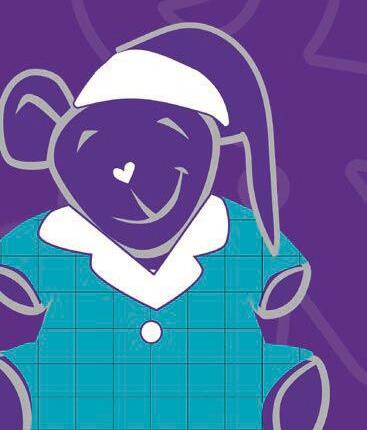











School is hard for some kids (and their parents).
We might not know why our child is struggling, or how to support them or we might have a hard time asking the school for help. We might not even know that asking the school is an option.
Talking to the teacher, staff or administrators about our kid’s challenges can be overwhelming. So how do we work with our child’s support team to get help for them? And how do we help our kids at home?
For me, talking to my child’s teacher about her challenges with school wasn’t easy. When going to school became hard
for my daughter, I had no clue how to approach her teacher about it. How could I share my daughter’s struggles with school and my parenting difficulties with a teacher I barely knew? The only words her teacher and I had exchanged were brief greetings in the hallway at drop-off and pick-up time.
What was I supposed to say to her teacher?
“My daughter doesn’t like school, I don’t know why, I don’t know what to do about it and I don’t know how we’ll get through the school year. And by the way, can you help us?”
That conversation felt like a big leap— a vulnerable risk.
FamilySmart’s Family Peer Support Workers can support parents and caregivers through those hard times with their child’s or teen’s mental health. They can also help families to find community and provincial support or services.
In the FamilySmart video Working Together: Families and Schools, Ashley Ragoonaden, principal at École KLO Middle School in Kelowna, speaks to FamilySmart’s Programs Director Victoria Keddis about creating relationships with your child’s school.
He and Keddis speak about parents and educators working together to build positive relationships with children and




teens by focusing on their strengths and interests.
“Find out what their definition of success is,” says Ragoonaden.
“What are the things they would like to achieve? It’s about building trust, positive relationships and using the right language with them. From there, what are their interests? What are they good at? And then build a system around (that).”
When my daughter struggled with school, a teacher who had a similar approach to Ragoonaden’s helped me focus more on my daughter’s strengths and interests, and less on the hard stuff. I learned to enjoy and celebrate the things that were going well for her and the things that she loved.
With that mind shift, I became a more relaxed parent. Her school experiences still weren’t easy, but after time, her strengths and love for music carried her through her challenges.
When we connect with our kids through their strengths and interests, we can begin to learn more about them.
Ask yourself how you can be creative about focusing on the things they love, or the things they are good at, so that you can build deeper connections with them.
When we build a strong relationship with our child, it’s more likely they will talk to us about their experiences and feelings. And when we build relationships with their teachers, it can make it easier to ask for help. We might even
learn something about our child’s experiences at school. This approach can empower us and make us feel less alone.
As Ragoonaden explains, we can benefit from having a growth mindset, something he says is an approach that tells our kids that even if things aren’t going well now, we (the parents and the school) will find a way to support them.
“It’s about empowering your young person to say, ‘I am struggling now. Mom and dad, can you help me get better?’” he adds.
“Let the child know, ‘No matter what the struggles are, we can find a way to help you. We just haven’t found it yet.’”
Even then, it can be hard to not beat ourselves up or to feel like you should have this parenting thing all figured out. Through no fault of our own, sometimes it takes extra time and patience to learn and to make things easier. If you have a tendency to take on the blame, Ragoonaden has another message: Forgive yourself.
Learn more about FamilySmart’s programs and access resources such as the video featuring Ragoonaden and many more at familysmart.ca

Colleen Clark is a mom with lived experience. She works for FamilySmart, a non-profit that offers free support to parents and caregivers of children and youth facing mental health and substance use challenges.











When the air turns crisper and leaves start to glow golden, Vancouver Island transforms into a fall playground— perfect for families on a budget. This season, explore magic, local markets and cozy outdoor escapes without spending a fortune.
Esquimalt Lagoon Migratory Bird Sanctuary, Colwood: A free and peaceful spot for birdwatching during peak migration season. Come with binoculars to catch all the birds in the trees and enjoy the seasonal flurry of geese and shorebirds. esquimaltlagoon.com
Sooke Regional Museum, Sooke: Located just off Highway 14 in Sooke, the Sooke Regional Museum delights families with indoor exhibits on First Nations culture, logging, mining, maritime history, plus outdoor artifacts like a rescued lighthouse and blacksmith shop. This donation-based museum also serves as a Visitor Information Centre and includes a lovely gift shop. sookeregionmuseum.ca
Duncan Farmers’ Market, Duncan: A year-round Saturday market with local produce, crafts and homemade goodies. Walk around, soak up the harvest vibe— it’s all free to browse and enjoy the entertainment on site. duncanfarmersmarket.ca
Bright Angel Regional Park, Duncan: A peaceful gem with forested trails, a kid-loved suspension bridge, playground, picnic shelters and river access. Perfect for a crisp fall day visit. cvrd.ca

Bamberton Provincial Park, Mill Bay: A tranquil beach and woodland park on the Saanich Inlet. It’s a quiet, scenic spot for family walks or beachcombing. bcparks.ca
Somenos Marsh & Boardwalk, Just beyond Crofton: This wildlife refuge showcases migratory birds with accessible boardwalks and peaceful views—it’s nature’s free fall spectacle. somenosmarsh.com
Chemainus Murals Walking Tour, Chemainus: Stroll through town exploring more than 40 stunning outdoor murals that chronicle local history and culture. Grab a self-guided map—it’s totally free and creativity-packed. visitchemainus.ca
Harbourfront & Nanaimo Bastion, Nanaimo: Although the Bastion is only open during the summer, you can wander along the scenic waterfront and snap some cool photos near the beautiful and historic

Nanaimo Bastion. It’s a quiet stroll and a slice of local history. nanaimomuseum.ca
Englishman River Falls & Little Qualicum Falls, Qualicum Beach: Two stunning waterfall parks, each offering easy family-friendly loop trails surrounded by brilliant fall foliage. Catch sight of salmon spawning in late fall for an added spectacular bonus. bcparks.ca
Farmers Markets & Coombs Old Country Market, “Goats on the Roof” in Coombs: Wander morning markets in Qualicum, park for free, chat with bakers and grab local snacks. Don’t miss the quirky goats grazing on Coombs Market’s rooftop—it’s a fun stop for all ages. oldcountrymarket.com
Port Alberni Museum & Maritime Discovery Centre, Port Alberni: Explore local history, First Nations culture and interactive exhibits that engage all ages. It’s a great way to spend a rainy fall day with a family rate of just $25. portalbernimaritimeheritage.ca
Fossli Provincial Park & Sproat Lake, Port Alberni: Hike to a historic homestead site amid stunning autumn foliage or enjoy lake-side views with fall’s incredible fire-hued palette. bcparks.ca
Amphitrite Point Lighthouse & Lighthouse Loop, Ucluelet: Part of the Wild Pacific Trail, this stroller-friendly 2.6km loop delivers dramatic coastal views, and a historic 1915 concrete lighthouse. The lighthouse tower is off-limits, but the grounds are free to explore, mak-
ing it perfect for families craving accessible, scenic adventure. wildpacifictrail.com
Quatsino Provincial Park Wilderness Escape, Port Alice: Primitive and peaceful, this is a real hidden gem! It’s great for mid-fall kayaking or hiking trips among bald eagles, old-growth forest and coastal wildlife. bcparks.ca
Nymph Falls & Salmon Watching, Black Creek: Here is an easy forest walk ending at Nymph Falls with opportunities to spot salmon swimming upstream in November. comoxvalleyrd.ca
Courtenay Riverway Heritage Walk/ Bike Path, Courtenay: This is a scenic, flat path perfect for family strolls or bike rides along the river. courtenay.ca
Comox Air Force Museum & Heritage Air Park, Comox: This donation-based museum showcases aircraft and aviation history, including a heritage hangar and cool outdoor displays. comoxairforcemuseum.ca
Shamrock Farm Pumpkin
Picking & Fall Treats, Comox: Affordable pick-your-own pumpkins and seasonal delights await your family at this unique family-friendly farm. shamrockfarm.ca
Elk Falls Provincial Park & Suspension Bridge, Campbell River: Experience dramatic waterfalls and canyon views from a suspension bridge. It is totally accessible and free to visit. bcparks.ca






Halloween is just around the corner and kids are thinking about their costumes. This is a wonderful time to channel their energy with easy projects and encourage their creative expression.
Here are four craft ideas to help guide their decisions. These fun projects can be accomplished with little effort and with basic supplies from around the house or a trip to a craft or dollar store.
Add some flair and spooky colours to a pair of old blue jeans or jean skirt with splashes of paint. All you need is orange, black and white fabric paint and paintbrushes. This is a messy project, so be sure to protect any furniture or flooring with old sheets. Begin with white strokes of paint all over the jeans. Then, brush on orange and black in long, curving strokes. Try flicking or spattering the paint too. To finish off,






Journeys of the Heart is a culturally-rooted drop-in program for Indigenous Children aged 0–5 years and their parents/caregivers/relatives.
Participation in the following activities will support positive cultural identity and lifelong learning:
Circle time • Moe the Mouse • Seeds of Empathy • Honoring our Wing Chief Free Play • Curriculum • Snack Time • Outside Play • Physical Activity • Fieldtrips
Program runs Monday and Wednesday 9 to 11:30 am (closed stat holidays) Program starts October 6 and runs until the second week of June
For further information please contact Sarah McDonald at 250-590-5048 or smcdonald@hulitan.ca
A program of Hulitan Family & Community Services Society Hulitan Early Years Centre 2125 Sooke Rd 250-590-5048 hulitan.ca








sprinkle with glitter glue. Be creative and flexible! Add your own touches. Let the jeans dry before wearing them to school to show your friends.
These brooches or pins are fun to wear in October. Make several and give them to your friends to wear at Halloween parties or while trick-or-treating. Cut two orange felt pumpkin shapes about two inches around. Glue them together with fabric glue. Decorate the pumpkin face with googly eyes, a black felt triangle nose and black felt mouth. Glue on a one-inch green pipe cleaner stem. Next, cut a piece of stiff cardboard the same size as the pumpkin and glue it to the back of the pumpkin. Tape a safety pin to the back and then pin it onto your costume. Try other designs such as a black cat, bat or ghost.
Make several of these fun necklaces and give them to your friends. To make the pom-poms, wrap orange and black yarn around two fingers (for small pom-poms) or four fingers (for larger pom-poms). Keep wrapping the yarn around your fingers many times until you’ve created a large ball around them. Then, carefully slide the yarn off your fingers and tie a piece of yarn around the center in a tight knot. Cut through the loops on both sides of the pom-pom, shake and trim. Create as many pom-poms as needed for the necklace. Thread a needle with a long length of yarn and then push the needle through the centre of each pom-pom and space them on the yarn to create the necklace.
Add pizzazz to your pants or jeans back pockets! Using a piece of white chalk or an erasable marker, draw a large pumpkin shape on the back pockets of your pants. Using orange embroidery floss and a needle, stitch around the outer edge of the pumpkin using a chain stitch. (Google how to chain stitch on YouTube). Stitch the eyes and mouth with black embroidery thread and the stem with green thread. Let your needle be your pencil!


Dads
Parenting
1-1















Benny delivers a “better-for-you” energy drink created by UVic grads who were looking for a drink that gave energy that didn’t soon fizzle out. It blends yerba mate with brain-boosting adaptogens like lion’s mane, reishi and ashwagandha—offering a jitter-free, low-sugar boost that supports focus and wellness. Find Benny online or in various stores on Vancouver Island and beyond! drinkbenny.com

Launched in 2024, Old Habits Fermentation in Port Alberni brings West Coast flavour to a classic Vancouver Island staple. Their fish sauce, made with only two simple ingredients—local wild-caught seafood and barrel-aged salt fermentation—delivers savoury depth without artificial additives. oldhabitsfermentationco.com

Triestina Pasta & Provisions offers handcrafted or bronze-die-extruded artisan pastas, gnocchi, focaccia, Italian dolci, cheeses and charcuterie. Made in Victoria using local organic wheat and seasonal ingredients, everything is slow-dried or lovingly prepared by Italian chef Massimo Buggini for authentic West Coast flavours. Visit their new store in Saanichton or order online. lapastatriestina.com




Ministry approved BC curriculum Kindergarten to Grade 12 program
Contemporary Indigenous Studies 12 available for enrollment
Full time or part time available Grade 10 to 12
Adult learning options
Grade 8 to 12: over 50 course options
Innovative learning management system
Experienced online learning teachers
Opportunities for self-paced, flexible, convenient learning
Direct teacher support available
Develop communication and technical online skills registering full-time or for a single course